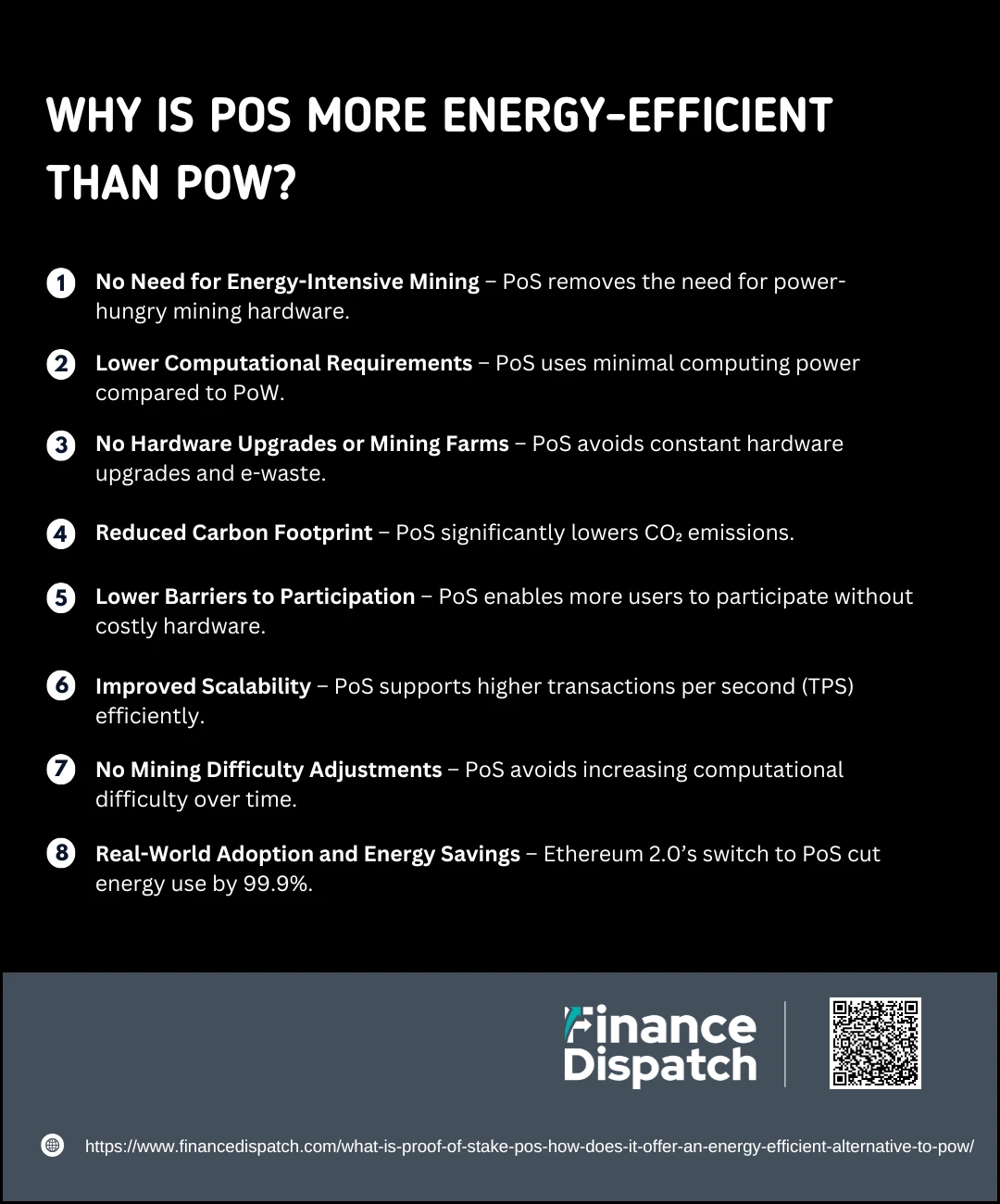Blockchain technology has revolutionized the way digital transactions are recorded and verified, but its underlying mechanisms vary significantly in terms of efficiency, scalability, and energy consumption. The earliest and most well-known consensus mechanism, Proof of Work (PoW), powers networks like Bitcoin but comes with a major drawback—its excessive energy consumption. PoW requires miners to solve complex mathematical puzzles, leading to high electricity usage and environmental concerns. In response, Proof of Stake (PoS) emerged as a more sustainable alternative, replacing computational power with economic staking to secure the network. By allowing validators to participate based on the amount of cryptocurrency they “stake” rather than the processing power they contribute, PoS significantly reduces energy usage while maintaining security and decentralization. This article explores how PoS works, its advantages over PoW, and why it is becoming the preferred consensus mechanism for modern blockchain networks.
What is Proof of Stake (PoS)?
Proof of Stake (PoS) is a consensus mechanism used in blockchain networks to validate transactions and maintain security without relying on energy-intensive computations. Unlike Proof of Work (PoW), where miners compete to solve cryptographic puzzles, PoS selects validators based on the amount of cryptocurrency they stake as collateral. This means that instead of using powerful hardware to secure the network, participants lock up their digital assets to gain the right to validate transactions and add new blocks to the blockchain. The more a participant stakes, the higher their chances of being chosen as a validator. This process not only makes blockchain operations more energy-efficient and scalable but also reduces the environmental impact associated with traditional mining. Many modern blockchain projects, including Ethereum 2.0, Cardano, and Polkadot, have adopted PoS due to its ability to support high transaction speeds while maintaining decentralization and security.
 How Does PoS Work?
How Does PoS Work?
Proof of Stake (PoS) is a blockchain consensus mechanism designed to validate transactions and secure the network in a more energy-efficient manner compared to Proof of Work (PoW). Instead of relying on miners solving complex mathematical puzzles, PoS selects validators based on the amount of cryptocurrency they stake as collateral. This means that participants who lock up a certain amount of their digital assets gain the opportunity to validate transactions and propose new blocks. The more a participant stakes, the higher their probability of being chosen. This process not only eliminates the need for expensive mining equipment but also reduces energy consumption, increases transaction speed, and enhances network security. Below is a step-by-step explanation of how PoS functions:
1. Staking Cryptocurrency
To become a validator in a PoS network, participants must lock up a certain amount of cryptocurrency in a staking pool. This staked amount acts as a financial commitment that ensures validators have a vested interest in maintaining the network’s integrity. The more they stake, the higher their chances of being selected.
2. Selection of Validators
Validators are chosen based on various criteria, including the amount staked, staking duration, and randomization techniques. While some PoS networks prioritize those with larger stakes, others use hybrid models to ensure fairness and decentralization. Some networks also introduce governance models, where validators with higher reputation scores gain preference.
3. Transaction Validation
Selected validators verify transactions within the network to ensure they comply with the blockchain’s rules. This step is crucial for preventing fraudulent activities like double-spending, where someone attempts to use the same cryptocurrency twice. Validators confirm transaction legitimacy before including them in a new block.
4. Block Proposal and Consensus
Once a validator successfully verifies transactions, they propose a new block to the network. Other validators then review and verify the proposed block’s accuracy. To maintain security, the system requires a majority of validators to reach consensus before the block is officially added to the blockchain.
5. Earning Rewards
Validators receive rewards in the form of transaction fees or newly minted cryptocurrency. This serves as an incentive for them to continue securing the network. Unlike PoW, where miners receive block rewards through computational effort, PoS rewards participants for simply staking and participating in the validation process.
6. Slashing for Misbehavior
To maintain security, PoS networks have a slashing mechanism that penalizes validators engaging in dishonest behavior. If a validator attempts malicious activities like creating conflicting blocks or validating fraudulent transactions, they lose a portion of their staked funds. This economic penalty ensures that validators act in the best interest of the network.
7. Unstaking and Withdrawal
Validators can choose to unstake their funds after a predefined lock-up period. However, some networks impose waiting periods or withdrawal fees to prevent mass unstaking, which could destabilize the network. Those who remain staked continue to earn rewards while contributing to the network’s security.
 Why is PoS More Energy-Efficient than PoW?
Why is PoS More Energy-Efficient than PoW?
Blockchain networks require a consensus mechanism to validate transactions and maintain security. The two most common methods are Proof of Work (PoW) and Proof of Stake (PoS). While PoW relies on miners solving complex mathematical puzzles using massive computational power, PoS selects validators based on their staked cryptocurrency. This fundamental difference makes PoS a much more energy-efficient alternative to PoW. By eliminating the need for high-powered mining rigs and reducing energy-intensive computations, PoS significantly cuts down on electricity consumption, making blockchain technology more sustainable. Here’s why PoS is far more energy-efficient than PoW:
1. No Need for Energy-Intensive Mining
PoW requires miners to use specialized hardware (ASICs) to solve cryptographic puzzles, consuming vast amounts of electricity. PoS, on the other hand, selects validators based on their stake, removing the need for competitive mining and reducing energy consumption dramatically.
2. Lower Computational Requirements
Mining in PoW networks demands continuous high-power processing, making it energy-intensive. PoS only requires basic computational power to verify transactions and propose blocks, making it far less resource-demanding.
3. No Hardware Upgrades or Mining Farms
In PoW, miners must constantly upgrade their hardware to stay competitive, leading to excessive e-waste and high operational costs. PoS validators only need a standard computer or server to participate, eliminating the energy drain associated with mining farms.
4. Reduced Carbon Footprint
PoW blockchains, like Bitcoin, consume as much electricity as small countries. PoS drastically reduces this environmental impact by operating on a stake-based model rather than computation-based, lowering CO₂ emissions and making blockchain technology greener.
5. Lower Barriers to Participation
PoW mining favors those with access to cheap electricity and powerful hardware, leading to centralization and monopolization. PoS allows anyone with a stake in the network to become a validator, reducing the need for energy-hungry mining rigs and increasing decentralization.
6. Improved Scalability
Since PoS does not rely on complex mathematical puzzles, it can process more transactions per second (TPS) with significantly lower energy consumption. This efficiency makes it better suited for real-world applications, such as decentralized finance (DeFi) and smart contracts.
7. No Mining Difficulty Adjustments
In PoW, the network increases mining difficulty as more miners join, requiring even more computational power and energy. PoS avoids this issue entirely by using a staking mechanism, making it a stable and energy-efficient system over time.
8. Real-World Adoption and Energy Savings
Ethereum’s transition from PoW to PoS (Ethereum 2.0) led to a reported 99.9% reduction in energy consumption. This shift demonstrates how PoS networks are significantly more sustainable and efficient compared to traditional PoW-based blockchains.
Comparison of Proof of Stake vs. Proof of Work
Blockchain networks rely on consensus mechanisms to validate transactions and maintain security. The two most widely used mechanisms are Proof of Work (PoW) and Proof of Stake (PoS). PoW, used by Bitcoin, requires miners to solve complex mathematical puzzles using powerful computers, leading to high energy consumption and expensive mining operations. In contrast, PoS selects validators based on the amount of cryptocurrency they stake, eliminating the need for energy-intensive computations. This fundamental difference makes PoS more energy-efficient, scalable, and environmentally friendly compared to PoW. Below is a detailed comparison of both mechanisms:
Proof of Work vs. Proof of Stake: Key Differences
| Feature | Proof of Work (PoW) | Proof of Stake (PoS) |
| Consensus Method | Mining through computational puzzles | Validators chosen based on staked assets |
| Energy Consumption | Extremely high (requires heavy electricity usage) | Low (removes need for mining) |
| Hardware Requirements | Specialized mining equipment (ASICs, GPUs) | Standard computer or server |
| Transaction Speed | Slower due to mining competition | Faster due to efficient validation |
| Scalability | Limited (high energy demand, slower processing) | Highly scalable (efficient and low-cost validation) |
| Security | Resistant to 51% attacks but prone to mining centralization | Economic penalties discourage attacks (slashing mechanism) |
| Decentralization | Mining pools may centralize control | More inclusive participation |
| Environmental Impact | High carbon footprint | Eco-friendly with minimal energy use |
| Examples of Cryptocurrencies | Bitcoin (BTC), Litecoin (LTC) | Ethereum 2.0 (ETH), Cardano (ADA), Polkadot (DOT) |
 Advantages of Proof of Stake
Advantages of Proof of Stake
Proof of Stake (PoS) is a more energy-efficient and scalable alternative to traditional Proof of Work (PoW). By eliminating the need for power-hungry mining operations, PoS significantly reduces energy consumption while maintaining security and decentralization. Instead of competing to solve complex mathematical puzzles, validators are chosen based on the amount of cryptocurrency they stake in the network. This mechanism offers numerous benefits, making PoS the preferred choice for modern blockchain networks. Below are the key advantages of PoS:
1. Energy Efficiency
PoS eliminates the need for intensive computational work, drastically reducing electricity consumption. Unlike PoW, which requires specialized mining hardware, PoS networks can operate with standard computers, making them eco-friendly and sustainable.
2. Lower Transaction Fees
Since PoS blockchains require less energy and infrastructure, they can process transactions at a lower cost. This results in cheaper transaction fees, benefiting both users and developers building applications on these networks.
3. Faster Transactions and Scalability
PoS networks can process more transactions per second (TPS) compared to PoW. Without the bottleneck of computational mining, PoS blockchains achieve higher throughput and faster confirmation times, making them more suitable for decentralized applications (dApps) and financial services.
4. Accessibility and Inclusivity
Becoming a validator in a PoS network requires staking cryptocurrency rather than investing in expensive mining hardware. This allows more users to participate, promoting decentralization and reducing the dominance of large mining farms.
5. No Mining Hardware Required
PoS does not rely on specialized mining equipment such as ASICs (Application-Specific Integrated Circuits). This lowers the barrier to entry for participants, making it more cost-effective and environmentally sustainable.
6. Economic Security Through Slashing
PoS networks use slashing penalties to discourage malicious behavior. If a validator attempts to manipulate the system, they risk losing a portion or all of their staked funds. This ensures honest participation and network security.
7. Reduced Centralization Risks
PoW mining often leads to concentration of power in the hands of large mining pools, reducing decentralization. PoS, however, encourages a wider distribution of validators, making the network less vulnerable to monopolization.
8. Sustainable Blockchain Future
With the growing concerns over climate change and high energy consumption, PoS offers a more sustainable alternative to traditional mining. Ethereum’s shift from PoW to PoS resulted in a 99.9% reduction in energy consumption, showcasing the potential of staking-based systems.
 Challenges and Criticisms of Proof of Stake
Challenges and Criticisms of Proof of Stake
While Proof of Stake (PoS) offers significant advantages such as energy efficiency, scalability, and lower transaction costs, it is not without its challenges. Critics argue that PoS can lead to centralization risks, security vulnerabilities, and economic inequalities within blockchain networks. Unlike Proof of Work (PoW), which requires computational effort to validate transactions, PoS selects validators based on the amount of cryptocurrency they stake, raising concerns about fairness and security. Below are some of the key challenges and criticisms associated with PoS:
1. Wealth Concentration and Centralization
In PoS, those who stake more cryptocurrency have higher chances of becoming validators and earning rewards. This can lead to wealth concentration, where early adopters or large stakeholders gain disproportionate control over the network, potentially reducing decentralization.
2. 51% Attack Risks
Although PoS reduces the risk of a 51% attack (where a single entity gains control over the network), it is not immune. If a wealthy participant acquires more than 50% of the staked tokens, they could manipulate the blockchain, reversing transactions or censoring other validators.
3. The “Nothing at Stake” Problem
One major criticism of PoS is the “Nothing at Stake” problem. Since validators do not have to expend energy to propose new blocks, they might attempt to validate multiple conflicting chains simultaneously without any risk. This can lead to blockchain forks and instability.
4. Initial High Entry Barriers for Validators
Becoming a validator in a PoS system often requires staking a significant amount of cryptocurrency. For example, Ethereum 2.0 requires 32 ETH to participate in validation, making it expensive for small investors to join the network directly.
5. Slashing Risks and Validator Penalties
Validators can face “slashing,” a penalty where they lose a portion of their staked funds if they act dishonestly or fail to perform their duties correctly. While this ensures security, accidental errors or technical failures can also lead to unintended financial losses.
6. Sybil Attack Vulnerabilities
PoS networks are sometimes vulnerable to Sybil attacks, where an attacker creates multiple validator identities to gain an unfair advantage in the network. While many PoS systems implement measures to prevent this, it remains a potential risk.
7. Dependence on Active Participation
For PoS to function effectively, validators must remain online and active. If too many validators fail to participate, the network can experience delays and inefficiencies.
8. Unproven Long-Term Security
PoW has been tested extensively for over a decade and is known for its robust security. PoS, however, is relatively newer and has not been tested at the same scale as PoW, making some critics question its long-term security.
Notable Blockchain Networks Using PoS
Proof of Stake (PoS) has become the go-to consensus mechanism for modern blockchain networks due to its energy efficiency, scalability, and cost-effectiveness. Unlike Proof of Work (PoW), which relies on energy-intensive mining, PoS allows users to stake cryptocurrency to validate transactions and secure the network. Many leading blockchain projects have adopted PoS, each offering unique features to improve speed, decentralization, and interoperability. Below are some of the most notable PoS-based blockchains:
- Ethereum 2.0 (ETH) – Transitioned from PoW to PoS, reducing energy consumption by 99.9% and enabling faster transactions.
- Cardano (ADA) – Uses the Ouroboros protocol for security, decentralization, and low-fee transactions.
- Polkadot (DOT) – Features Nominated PoS (NPoS) and parachains for cross-chain interoperability.
- Solana (SOL) – Combines Proof of History (PoH) with PoS for ultra-fast transactions and low fees.
- Tezos (XTZ) – Uses Liquid PoS (LPoS), allowing token holders to delegate staking power.
- Avalanche (AVAX) – Multi-chain architecture with fast finality and low transaction fees.
- Algorand (ALGO) – Uses Pure PoS (PPoS) for fairness, decentralization, and low energy consumption.
- Cosmos (ATOM) – Implements Tendermint PoS for high-speed transactions and blockchain interoperability.
Conclusion
Proof of Stake (PoS) has emerged as a superior alternative to the energy-intensive Proof of Work (PoW) model, offering greater efficiency, scalability, and sustainability. By replacing computational mining with a staking mechanism, PoS drastically reduces energy consumption, lowers transaction costs, and increases participation accessibility. Leading blockchain networks such as Ethereum 2.0, Cardano, Polkadot, and Solana have embraced PoS to enhance security, decentralization, and transaction speeds. Despite challenges such as wealth concentration and security concerns, continuous improvements and innovations in PoS mechanisms are addressing these issues. As the blockchain ecosystem evolves, PoS is set to drive the future of decentralized finance (DeFi), smart contracts, and Web3 applications, making blockchain technology more sustainable, efficient, and widely adopted.



